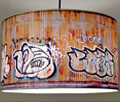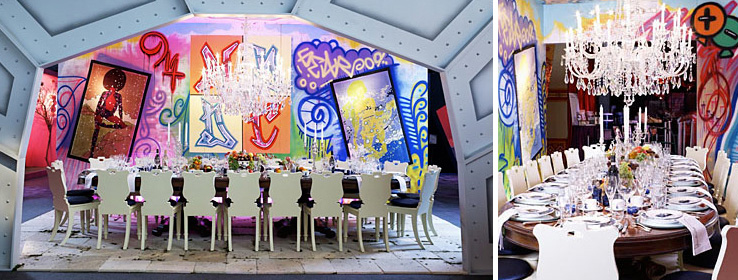Interior designer Kelly Porter has discovered that graffiti is now a glamorous and legit art form — inspiring creative professionals with its energy, style and dramatic colors.
Graffiti comes with baggage. It's often been associated with vandalism and gang activity. And for years it's stirred up sentiments – pro and con – about its legitimacy as an art form. However, in the midst of this debate, a shift has taken place. Graffiti is now trending toward the glamorous – showing up in chic places, on hip home furnishings and on high-end fashion accessories. Artists are being commissioned for their work, which is now know as urban, street and spray paint art. Creative professionals say they are inspired by this art form's energy, style and colors.
The graffiti-infused environment that designer Michael Tavano created for the New York Design Center at DIFFA's Dining By Design event last year is still generating buzz. Inspired by a dinnerware pattern, his colorful design showcased an elegant table surrounded by an edgy graffiti mural rendered by a local artist. "I wanted to take a baroque dining room and bring it to the streets," Tavano says. Color and contrast were central elements in his eye-catching design. Tavano told me that he admires the creativity that goes into street art and would like more people to "open their minds and see it as artwork." In fact, many ideas for the mural came from the artist himself. "We live with color all around us," Tavano says. "You can use a lot of color and still be comfortable." Personally, I couldn't agree more.
On a softer note, graffiti is just one element that completes the dining experience at the upscaleRare 120 steakhouse in Las Vegas. You'll find a subtle hint of graffiti scrawled across the restaurant's dining chairs. "People don't even realize the motif is graffiti," says owner Lonnie Moore, explaining that the overall vision was to create a "super modern, very female-friendly environment." I love how the custom black and white chairs serve as a neutralizer to the saturated burgundy and red tones in the space. However subtle, I surmise that graffiti was a key ingredient in designing the "cool, sleek and fun" atmosphere that Moore says his clientele wants.

And graffiti in interiors isn't limited to public spaces such as restaurants: "Street style" home furnishings are growing in popularity, too.
Michael Tavano was inspired by Lovegrove & Repucci's New York Delft dinnerware (the company also sells graffiti throw pillows).
Weegohome.com offers a colorful, urban collection of lighting fixtures and photo art.
London-based Luis Alicandu has designed a furniture collection that attempts to address those who think of graffiti as "non-artistic vandalism." Alicandu believes that using the essence of graffiti in design is a constructive way to legally express this true art form. His elegant Louffiti mirror merges a Louis XV style with that of graffiti. It can be custom-made in several colors.
Turning to fashion, graffiti has already made its mark on footwear and designer handbags, including collections by Louis Vuitton and Coach, and is now influencing jewelry design. Ken Leung's colorful jewelry collection at kenanddanadesign.com reflects the street art of New York City, which Leung describes as "a raw and unapologetic expression of emotion and rebellion." His perspective reminds me that graffiti is still a controversial art form. At the same time, Leung sees something else in it: "Art is a means of expression as well as communication. Through that prism, graffiti becomes a very beautiful art form." He says that graffiti's impact on fashion will broaden because it's just such bold acts of expression and creativity that the fashion world esteems.
Keenly aware that graffiti still carries a negative connotation, Chor Boogie calls himself a spray paint artist and emphasizes the positive aesthetic of this art form. While he's based in San Francisco, his work has taken him around the globe. Commissioned works include a mural at the Beijing 2008 Olympics in China and other public work in Australia; Dubai; Mexico; and Washington, D.C. He also does residential and canvas work. After viewing his portfolio, I was utterly amazed. Not only does he have command of his art medium, but his work is vivid, fluid and multicolored. "I don't discriminate when it comes to color," Boogie says. "I'll put any off-colors together and make it look beautiful."
Believing in the healing aspects of color, he calls his work "color therapy." "Consciously or unconsciously, color has an effect on you," he says. When I asked what he wants others to focus on when deriving color inspiration from his art, Boogie says that people should look at how the art makes them feel, however far they can take that perception. "Look for something from within … and go with what you feel is right." That may be easier said than done, but if the urban art craze continues, we'll have plenty more opportunities to become in tune with how it makes us feel.








